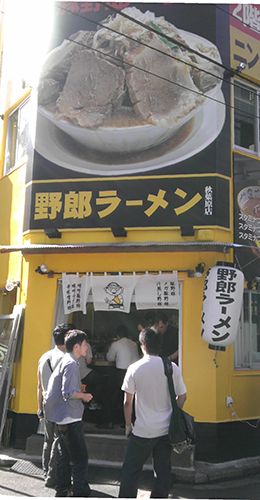166. The "Village" Radical: 里
The following kanji carries the Joyo kun-yomi さと:
里 (219: village; old unit of distance)
It makes sense, then, that the Japanese call the identical-looking "village" radical さと in that kanji and in the next two:
重 (311: heavy; serious, important; stack; duplicate)
量 (600: quantity; measurement; assessment)
When the radical slides to the left of a character, the name さとへん works:
野 (213: field; wild; outside the government; ambition; plain)
You've now seen all four Joyo kanji in which the 里 radical is on duty.
This seven-stroke shape has no variants. In 野, however, the 土 part features two rakishly angled horizontal strokes.
Photo Credit:
Eve Kushner
In Kawasaki City (in Kanagawa Prefecture, south of Tokyo), a playful sign outside an izakaya includes this bit:
炙里の料理は創作料理
Aburi cuisine is creative cuisine
炙里 (あぶり: restaurant name); 料理* (りょうり:
cuisine); 創作 (そうさく: creative work)
I love seeing the 里 shape appear three times, first in 里 itself, then twice in 理 as a mere component.
The non-Joyo 炙 means “to roast” and is quite a clear pictograph of that process. Kanjigen says that the character depicts “meat” (月) over “fire” (火). Isn’t it great when things make sense in the kanji world?!
Etymologies
To learn what 里 means in the four kanji in which this radical is on duty, I consulted Henshall's newer edition, finding these etymologies:
里 (219: village; old unit of distance; "village" radical)
The 田 means "field," and the 土 means "earth/ground," so the overall sense of 里 is "ground/land in form of paths or ridges separating fields." One scholar takes "village" to be loan usage. Another sees that definition as extended usage based on the idea of arranging dwellings in a grid pattern.
野 (213: field; wild; outside the government; ambition; plain)
This character combines 里 (village) with the phonetic 予 (already), which has the associated sense "calm, quiet." That's all Henshall says; he doesn't connect those meanings to current definitions.
重 (311: heavy; serious, important; stack; duplicate)
The character evolved to combine 亻 (person), 東 (originally "sack (with things inside)"), and 土 (earth, ground) on the bottom. Literally, then, 重 means "person standing upright (on the ground) with things in a sack." By extension that represents "heavy," as well as "pile up" and "-fold."
量 (600: quantity; measurement; assessment)
In one view, the upper part depicts the top of a sack to pour grain in, with the lower part originally meaning "sack." Together these components represent "measure" (originally pertaining to rice).

Photo Credit: Lutlam
A ramen place in the Akihabara section of Tokyo has an unexpected name—野郎 (やろう). The Japanese sometimes use 野郎 in a friendly way to mean "guy" or "dude." But in its negative sense this common term is vulgar, meaning something close to "jerk," so hardly anyone would even consider using it as the name of a shop or food. Perhaps somebody chose 野郎 here as a memorable, attention-getting name.
The restaurant serves 野郎ラーメン, which abounds in calories, ingredients, and seasonings and is meant for men. Apparently 野郎 can work as a synonym for ラーメン within the restaurant.
